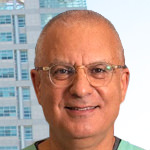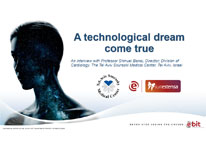An interview with Professor Shmuel Banai, Director; Division of Cardiology, The Tel Aviv Souraski Medical Center, Tel Aviv, Israel
"Throughout his career, Professor Shmuel Banai imagined having all his cardiology information together, in order to make his clinical and administrative workstreams more efficient, improving overall patient care, and creating additional capacity for further research and specialist teachings to be carried out in one of the leading cardiology research centres in the world. The end result with this new system has exceeded his wildest dreams".

Prof. Banai is the author of more than 200 peer-reviewed papers, book chapters, more than 400 abstracts, and has participated in many clinical and pre-clinical research studies in the field of cardiology, interventional cardiology, and pharmacotherapy; many of which initiated within his large research centre. He is also closely involved in the development of new medical devices, two of which are now in use in hospitals around the world.
The Tel Aviv Sourasky Medical Center is the largest cardiology centre in Israel, not just for its intensive cardiac care unit, Electrophysiology, Day Care and Outpatient department (the latter of which in 2020 has now grown in terms of its online capabilities), but also for its research.
“We are significantly important in the cardiology field and we strive to be a centre of excellence. Many of our physician cardiologists are proctors in their fields and travelled the world before Covid-19 to teach new devices, technologies and procedures” explains Prof. Banai.
Interview with Professor Shmuel Banai
The single most important development of the year
They now have a single IT system that collects all clinical data, measurements and images providing a complete cardiology patient history.
“We weren’t aware of just how much we were struggling with workflow optimisations until we have moved to this system” recalls Banai. “We don’t struggle anymore, we no longer find shortages in the system, a dependency on another system or file is a thing of the past !”.
New possibilities through continual developments
The full potential impact it can have on the diagnostic process is only now becoming clear. “Now it’s like a dream come true as everything is in one place. But even if we find something lacking, it’s already been identified by the developers as a future requirement in the roadmap and will be shortly added to the system functionality ”..
It is a CVIS that can be adapted to user needs, delivering reports in different languages and as Prof. Banai continues: “It’s more than a tool to review images on. It gives us complete control and manages every detail in every procedure in each corner across all of our department. You don’t believe how vital it is until you have it, and the more you use it, the more you realise how much more you can do with it ”..
More than just for managers
The system continues to evolve and astound, not just the management team, but also the physicians and nurses who have a tool that gives them complete control. The complete integration of the CVIS, the Hospital information systems, Central Warehouses and Smart Cabinets makes all the difference. Structured Reporting combining all the different data sources have improved the way physicians perform their jobs. “They now need to do less as Technicians who handle the system carry the admin workload, allowing physicians to focus on the science, research and, of course, patient care ”..
Efficiencies that roll into patient care
A patient-centric and evidence-based care process is now a cornerstone of the departments work because now all the data is accessible in one place, infinitely easier to interrogate, and is very reliable. Physicians can also easily share and plan activities together and this team based approach has improved diagnostic and therapeutic procedures.
“Heart Team meetings are now very fluid as we all can have our hands on different data – echographs, FFRs, CTs, nuclear medicine, ECGs all to hand in a matter of seconds” Prof. Banai underlines. “From 6:30am we can review every case from the previous day in the system. By 7:30am now we are already reviewing all new admissions including all of their images, ECG reporting, electrophysiology data from pacemakers ”..
Medical and financial control
The new system allows physicians more time to focus on their patients, whilst management of the hospital is also much easier as inventory, finance and stock deliveries are all supported with reliable data. “Gone are the notebooks and endless excel files! It’s a whole new world where we can produce reporting that can be used at a departmental and also hospital management level. Smart Cabinet integrations then allow inventory to be tightly controlled with data that goes right down to what one nurse used on any given day. It’s truly mind-blowing” proclaims Banai..
An IT partner that evolves with medical advancement
More than 80% of the hospital systems are now integrated but the IT partner continues to develop the software based on end-user requirements, which are wholly compliant with safety and quality standards for medical equipment. Prof. Banai is encouraging even more: “We want to have someone from their team working alongside us developing local customisations, which might be unique to our requirements, but won’t detract from the continual developments and improved capabilities of the system as a whole ”..
The future of IT in Healthcare and the evolution of CVIs and PAC system
Prof. Banai hasn’t stopped dreaming of an even better tomorrow with the IT partner: “Our hospital is a centre of excellence. Our Cardiology department has a significant international standing and we now have a competitive advantage thanks to this technology. But there are more and more systems beyond angiography, CT, FFR & MRI. The PACS system and CVIS need to work in harmony. That’s the ultimate dream now; to control all the imaging within the hospital, not just cardiology”..
Contact us for more information
Read other Clinical Stories
A career-long goal being realised
An interview with Professor Joachim Ehrlich Head of Cardiology and Electrophysiology St Josef’s Hospital in Wiesbaden, Germany...“
A new Heart Team patient centric philosophy
An interview with Prof. Carlo Trani, director of the Interventional Cardiology and Invasive Diagnostics Unit at Gemelli...



